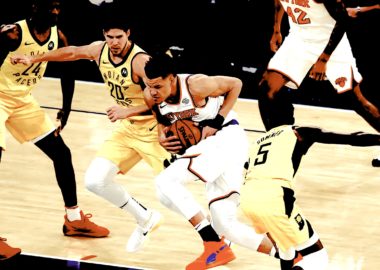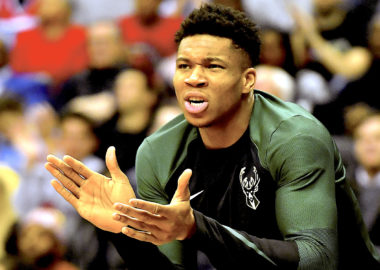
Self-Determination Theory and the contract year bump
What motivates people?
Well it turns out, and in a not overly surprising way, that there are a load of internal and external factors that have been studied on how they impact individual motivations. The general school of thought breaks it down into two main categories: intrinsic and extrinsic motivation.
As described by VeryWellMind.com, intrinsic motivation is as follows:
Intrinsic motivation involves engaging in a behavior because it is personally rewarding; essentially, performing an activity for its own sake rather than the desire for some external reward.
Applying it to basketball, intrinsic motivation would be working hard for the love of the game and not for the fame and fortune that comes with playing well.
Similarly, extrinsic motivation is as follows:
Extrinsic motivation occurs when we are motivated to perform a behavior or engage in an activity to earn a reward or avoid punishment.
And in its application to basketball, extrinsic motivation would be the desire to play well in order to earn a larger contract and also why players avoid wracking up technical fouls.
So where does the supposed contract year bump fall into all this?
As with most things in life, it is a bit of both. Getting a nice, fat contract, a form of extrinsic motivation, is going to theoretically push players to improve. But that can not be entirely separated from a player playing well because they love basketball and want to be the best version of themself they can be. And this duality between intrinsic and extrinsic motivation is broadly described using Self-Determination Theory.
Self-Determination Theory, or SDT for short, is a framework used for describing and studying how intrinsic and extrinsic motivations work in conjunction to help people achieve various goals and develop into the person they become.
As described by SelfDeterminationTheory.org, the theory is summarized as follows:
SDT articulates a meta-theory for framing motivational studies, a formal theory that defines intrinsic and varied extrinsic sources of motivation, and a description of the respective roles of intrinsic and types of extrinsic motivation in cognitive and social development and in individual differences.
Wow is that a lot of concepts to work through. Essentially, it’s just a way to frame motivation into neat categories according to their intrinsic and extrinsic motivational contributions and the end product of those motivations. There are six mini-theories of SDT, which I will not go into all of, but the one specific to the contract year bump is called Goal Contents Theory (GCT for short).
GCT looks at the combination of extrinsic and intrinsic motivation on achieving a goal, in this case getting a new contract.
There have been multiple studies on the supposed contract year boost, and most found at best murky results. It seems to have a little validity in both the NBA and MLB, where contracts are guaranteed and longer, but no truth in the NFL where the lack of guaranteed money is a continued extrinsic motivation for players. I was not able to find any studies on the contract year boost in the NHL.
I was not satisfied with just reading about it, and chose to replicate a study on the NBA to see if I found the same results. I looked at PER for three years of a player: a baseline year, a contract year, and a post-contract year. Players had to play at least 500 minutes in each season, and PER was adjusted using an age curve to eliminate age related noise as well as regressing PER to remove further noise. I chose PER because it was easily available and because it has an r^2 value greater than 0.75 with contract. This means that PER is a good measuring stick for what contract a player will receive and their overall market value.
My results were similar to the results found by Ken Sheldon and Mark White in one of the two above linked studies. I found that on average, a player in a contract year saw virtually no change in their PER from their baseline season. And similar to the above study I found that the year following a contract year, a player does decline to lower than their baseline season, a phenomenon Sheldon calls the contract year syndrome.
One thing I found was that for players who went on to earn contracts of three years or more, there was a bit of a contract year boost including an even larger drop to below their baseline season in their first post contract year. But the boost and the drop were still relatively small and would, hopefully, not results in a player really getting overpaid by that much money. A player being 1-2 percent better and then 2-3 percent worse is more likely normal year to year variation than something worth modeling into player projection.
The way this applies to all that motivational theory I started with is taken from an article in Science Daily on the same concept:
Extrinsic motivation is the psychological term that refers to a behavior driven by external rewards like money and fame. Sometimes these rewards work, at least temporarily, but the downside is that the reward can often undermine people’s intrinsic motivation, or their enjoyment and engagement in the behavior. This can lead to a decrease in intrinsic motivation and performance.
The very thing that can motivate someone to work hard, can lead to someone having less intrinsic motivation to perform once they reach that goal. And that makes sense. When someone works incredibly hard for all of their life to achieve becoming an elite athlete, and when that someone finally receives forever life changing compensation for their work, it’s entirely reasonable to take a little time off or push a little bit less hard because they have already achieved their wildest dreams.
You might see someone playing better this year in a contract year, that does not mean they are only playing better to get paid or that they will suddenly stop playing well next season. It seems to me to be a real thing, but a small one at best with too many outliers to generally call the contract year bump anything more or less than a player simply improving along a normal career trajectory. It is easy to attribute improvement to the extrinsic motivation of money, but there are too many other factors that go into it, and the data is too murky, to really make a concrete statement as to the existence of a contract year boost.


